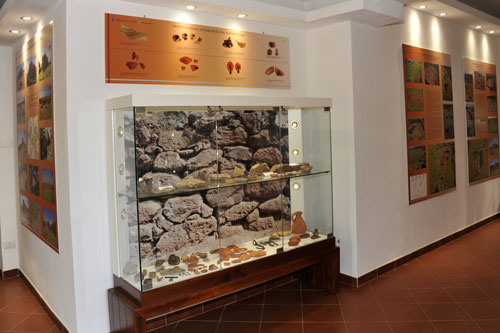Nuraghe Losa
map of Nuraghe Losa and Surroundings

The Nuraghe is one of the best-preserved in all of Sardinia.
The typical architecture of these structures is clearly recognizable, even though the upper sections of the towers have been removed.
Directly opposite the entrance to the Nuraghe, there is a wall of a circular building with a diameter of 6 meters (visible in the right half of the photo).
This building was likely part of the fortification. It has two entrances, one of which is directly in front of the Nuraghe entrance. Numerous niches are embedded in the walls. The narrow arrow slits served for defense and as light inlets.

The Nuraghe Losa consists of a main tower and a triangular bastion with three corner towers.
The complex was inhabited from the time of the Nuragic civilization (14th – 7th century BC) to the time of the Phoenician-Roman conquests (4th century BC – 4th century AD).
In the early Middle Ages (5th – 7th century AD), it was reused.
How to get there: The Nuraghe is located very close to the highway junction near Abbasanta.
Depending on the direction you’re coming from, the access can be a bit tricky to find among the maze of on and off ramps. However, the way is well signposted.
The parking lot and ticket office are directly next to an on-ramp.
 The monumental effort involved in the construction is best appreciated by visiting the interior of the Nuraghe.
The monumental effort involved in the construction is best appreciated by visiting the interior of the Nuraghe.
The passages and rooms in the triangular fortress can all be walked through, and a staircase leads up to the main tower.
This tower is still preserved up to a height of 13 meters. There was likely a terrace at the top.
 The main Nuraghe is surrounded by another wall with embedded towers.
The main Nuraghe is surrounded by another wall with embedded towers.
This outer wall and the partially preserved two towers are also equipped with arrow slits.
The two towers consisted of a single room inside, topped with a dome.
Under the outer wall of one tower, there is a cistern.
 A small exhibition is located in a building on the excavation site.
A small exhibition is located in a building on the excavation site.
It provides information about the history of the Nuraghe, its discovery in modern times, and the excavations conducted.
Several display cases showcase numerous artifacts from the Nuragic period.
The visit to the exhibition is included in the ticket price.

At the outer perimeter wall, the remains of a small Roman necropolis can still be seen.
In the 1st and 2nd centuries AD, cremation burials were carried out here.
The graves consisted of small rectangular cavities carved into small basalt columns or, in some cases, directly into the rock.
The cavities contained the ashes of the deceased and burial offerings. They were covered with a stone slab at the top.
